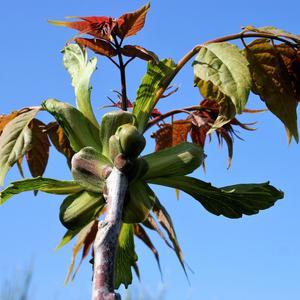1 September 2021
Ailanthus altissima, commonly known as tree of heaven, is native to China. It was introduced in Europe around 1740 for ornament but was also used as a fodder for the ailanthus silk moth (Samia cynthia), which was supposed to replace the mulberry silkworm (Bombyx mori).
Leaves are compound and imparipinnate. They consist of up to 25 ovate-lanceolate leaflets. The bark is pale grayish and smooth in young individuals and becomes rough and with longitudinal fissures with age. Usually the plant is dioecious, that is there are male and female individuals. Flowering occurs in May-June. Flowers are small, yellow-greenish, and clustered in large terminal panicles. Male plants have a foul odour while flowering. Fruits are gathered in pending clusters and are brightly colored (yellow, orange, and red) up to full ripening in September-October, when they become membranous. They are flat, winged and easily wind dispersed, and contain a single seed. All parts of the plant, especially the leaves, have a distinguishing strong odor.
The expansion of Ailanthus has been favored by its adaptability to infertile and poor sites, by the production of chemicals (such as ailanthone) that inhibit the growth of other species, by the rapid growth rate, prolific fruiting, high dispersal capacity and vigorous resprouting when cut.
Nowadays Ailanthus altissima is acknowledged as an important invader worldwide. It is widespread in most European countries (including Italy), in North America, Australia and New Zealand. It can outcompete native species in urban and anthropic areas (including archaeological sites) but can also invade forest edges, open gaps, and meadows.
In 2019 Ailanthus altissima entered the List of invasive alien species of Union concern, regularly updated since the Regulation EU 1143/2014. The species included in the Union list are subject to specific measures, which include restrictions on keeping, importing, selling, breeding, and growing. Member States are required to take measures for the early detection, rapid eradication and management of these species in natural habitats, where they compete with native species and threaten biodiversity conservation. Eradication of Ailanthus, however, is very difficult, because cutting stimulates the development of abundant shoots from roots and stumps, when untreated.
In the Ponziane islands, Ailanthus altissima occurs in a few sites in Ponza (main town and cemetery area) and Ventotene. In particular, the species is rapidly expanding at Punta dell’Arco (southern tip of Ventotene), where several young individuals are invading the grassland patches within the disturbed maquis.
